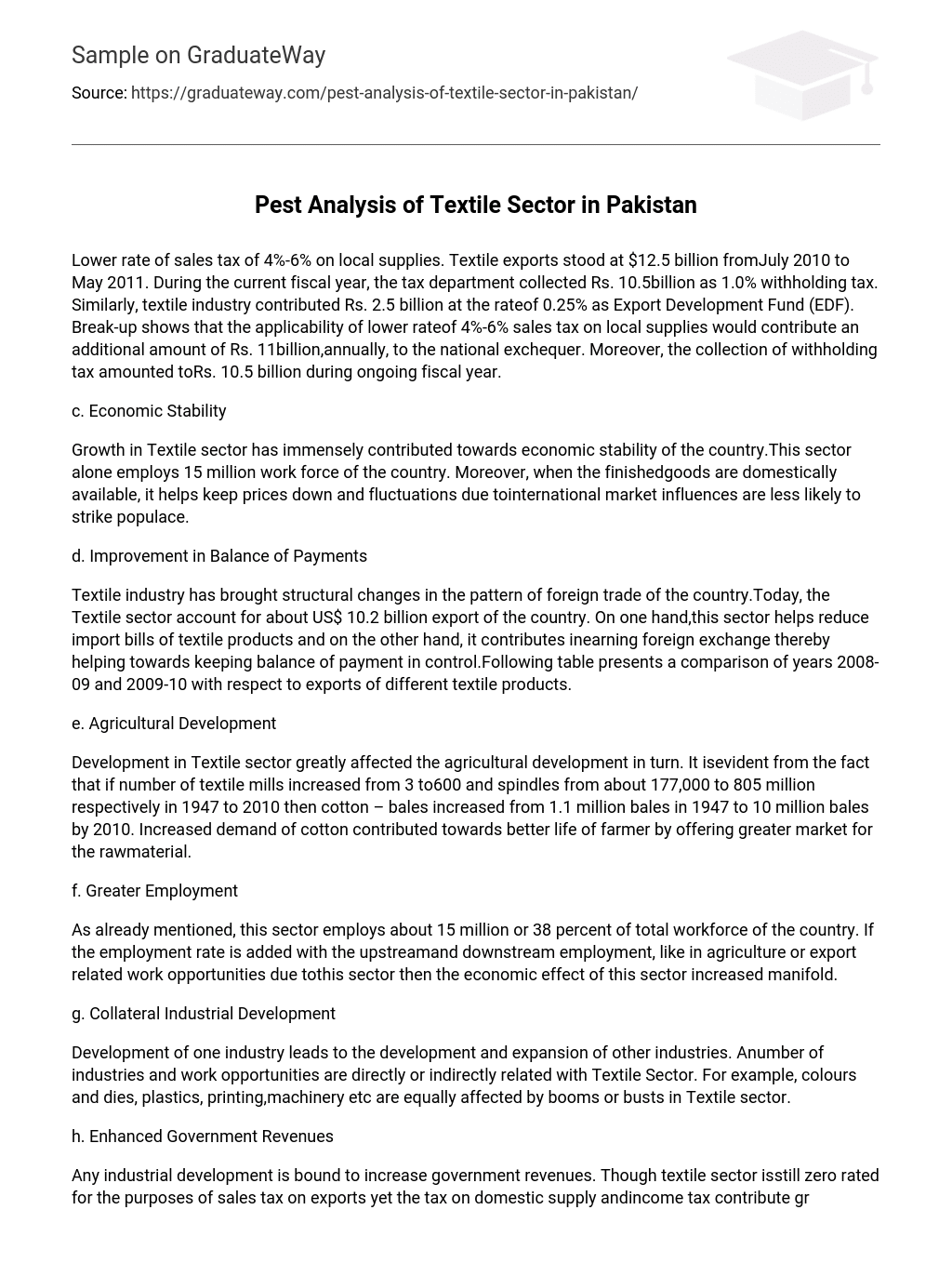Lower rate of sales tax of 4%-6% on local supplies. Textile exports stood at $12.5 billion fromJuly 2010 to May 2011. During the current fiscal year, the tax department collected Rs. 10.5billion as 1.0% withholding tax. Similarly, textile industry contributed Rs. 2.5 billion at the rateof 0.25% as Export Development Fund (EDF). Break-up shows that the applicability of lower rateof 4%-6% sales tax on local supplies would contribute an additional amount of Rs. 11billion,annually, to the national exchequer. Moreover, the collection of withholding tax amounted toRs. 10.5 billion during ongoing fiscal year.
c. Economic Stability
Growth in Textile sector has immensely contributed towards economic stability of the country.This sector alone employs 15 million work force of the country. Moreover, when the finishedgoods are domestically available, it helps keep prices down and fluctuations due tointernational market influences are less likely to strike populace.
d. Improvement in Balance of Payments
Textile industry has brought structural changes in the pattern of foreign trade of the country.Today, the Textile sector account for about US$ 10.2 billion export of the country. On one hand,this sector helps reduce import bills of textile products and on the other hand, it contributes inearning foreign exchange thereby helping towards keeping balance of payment in control.Following table presents a comparison of years 2008-09 and 2009-10 with respect to exports of different textile products.
e. Agricultural Development
Development in Textile sector greatly affected the agricultural development in turn. It isevident from the fact that if number of textile mills increased from 3 to600 and spindles from about 177,000 to 805 million respectively in 1947 to 2010 then cotton – bales increased from 1.1 million bales in 1947 to 10 million bales by 2010. Increased demand of cotton contributed towards better life of farmer by offering greater market for the rawmaterial.
f. Greater Employment
As already mentioned, this sector employs about 15 million or 38 percent of total workforce of the country. If the employment rate is added with the upstreamand downstream employment, like in agriculture or export related work opportunities due tothis sector then the economic effect of this sector increased manifold.
g. Collateral Industrial Development
Development of one industry leads to the development and expansion of other industries. Anumber of industries and work opportunities are directly or indirectly related with Textile Sector. For example, colours and dies, plastics, printing,machinery etc are equally affected by booms or busts in Textile sector.
h. Enhanced Government Revenues
Any industrial development is bound to increase government revenues. Though textile sector isstill zero rated for the purposes of sales tax on exports yet the tax on domestic supply andincome tax contribute greatly to government revenues.
i. Diversification of Economy
Development in textile sector has helped in diversifying economy by reducing dependence onmere production and export of raw material. It also instilled diversification by stimulatingcollateral industrial development.
3. Social Analysis:
Social Factors Affecting Pakistan Textile Industry:
Globalisation
. Textile industry products sold in the Pakistan originate from all around the world,often from developing countries. This global trade can lead to improved economies, andcreates employment for many people – often women – providing them with financial stability and a chance to escape poverty. But the process is not perfect, with low wages, poor worker’s rights (inadequate health and safety, long hours, no contracts) and child labour apparent insome countries.
Workers rights/Education
. Falling prices of textile products of Pakistan have put cheap production in demand all alongthe supply chain, from pickers and labourers on farms to factory workers. There is added pressure on producers to cut corners, and workshops with poor standards are seen as a ‘hidden’ way to do this .Much of the manufacture of garments employs unskilled – or low skilled – workers who lack of knowledge of rights, or are prevented from joiningtogether in trade unions.
Health and Safety.
Workshops in developing countries can have less stringent restrictions through regulations thanthose apparent in the UK or more developed nations. Wheras in Pakistan Textile industry Where working conditions are poor, workers’ health can suffer (with the likes of backache, eyestrain, burns and other injuries. There are even reports of restricted allowance of toilet breaks, leaving workers with severe kidney problems). And when long hours – up to 16hour days in some countries – are factored in, fatigue can compound the likelihood of accidents.
Animal Welfare
. With materials such as wool, leather and fur, farming and handling of animals is an integral part of theproduction process. Poor farming practice can lead to neglect or mistreatment of animals, with malnutrition, infectionsand illness potential symptoms. Some countries have much less restrictive regulations to protect animal welfare, particularly in respect of transportation, slaughter and processes such as ‘tooth – grinding’ and ‘mulesing’
4. Technological Analysis:-
Textiles consist of fibers, yarns, fabrics and finishes. Each of these stages has a variety of processes involved to reach the next stage .Technical textiles offer an excellent opportunity tocontribute in economy and also a new direction, new ways and means to sustain in the nearfuture. An average of 4% growth in technical textiles was expected during the period from1995-2005 and almost it is gained.Some of the machineries includes in various departments of Textile Industry such as: • Blow room
• Carding
• Combing
• Weaving
• Bleaching
• Testing
• Finishing
now a days textile industry totally become computerized because of time and preferenceschanging of customer. All designs designed on computerized system first then using heavymachines product came into existence In 1990 to 2000 era when Chinese revolution not camethen mostly Japanese and expensive machines used in Pakistan. There are many drawbacks andone is that the maintenance cost is much higher then its production. If there was any fault inmachine then a foreign engineer is hired and calls him to come in that country and repair it. Socost increased rapidly.To maintain the quality some of the following machines introduced and used to reduce cost,time, labor and quick finishing:1.





